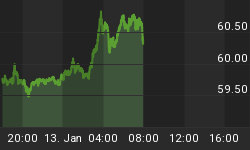In last week's Hybrid Lindsay forecast, Middle Section forecasts from both the Basic and Multiple cycles pointed to a high for the November run-up in the Dow on Monday, November 23. As of last Friday, both the closing and intra-day highs occurred one trading day early, the previous Friday, November 20.
Moving from the Dow Industrials to small caps... according to Stock Traders' Almanac, the January Effect (the tendency for small caps to outperform large caps in January) now begins in mid-December. The chart below shows the relative performance of small caps (RUT) versus the broader market (SPX). In October, the ratio tested the low of the last four years set during the previous October. A bearish head-and-shoulders pattern can be seen in the relative performance chart in 2015. The pattern has been triggered and forecasts a minimum decline to lows not seen since 2009.
Underperformance by small and mid-caps is a classic late cycle performance phenomena and is yet another arrow in the bear market quiver but none of the above necessarily rules out a period of outperformance by small caps during the coming December/January.

To get your copy of the December Lindsay Report click here.
















